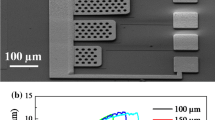Abstract
This paper presents the investigation on the effect of different designs of Stress Concentration Region (SCR) on the change of resistance in piezoresistive microcantilever using Finite Element (FE) analysis. Two steps solution using memMech and memPzr solvers in Conventor is used in FE analysis in order to obtain the resistance change directly from microcantilever. Simulation results show that cantilever with SCR circle design gives the desired highest magnitude and broader stress distribution region thus contributing to the most significant result for piezoresistive effect.






Similar content being viewed by others
References
Ansari MZ, Cho C (2009) Deflection, frequency and stress characteristics of rectangular, triangular and step profile microncantilevers for biosensors. J Sens 9(8):6046–6057. doi:10.3390/s90806046
Bashir R, Gupta A, Neudeck GW, Elfresh MM, Gomez R (2000) On the design of piezoresistive silicon cantilevers with stress concentration regions for scanning probe microscopy applications. J Micromech. Microeng. 10:483–491
Bhatti MA, Xi LC, Zhong LY, and Abdalla AN (2007) Design and finite element analysis of piezoresistive cantilever with stress concentration holes. In: IEEE conference on industrial electronics and applications. pp 1171-1174
Finot E, Passian A, Thundat T (2008) Measurement of mechanical properties of cantilever shaped materials. J Sens 8(5):3497–3541. doi:10.3390/s8053497
Firdaus SM, Azid IA, Sidek O, Ibrahim K, Hussein M (2010) Enhancing the sensitivity of a mass based piezoresistive micro-electro-mechanical systems cantilever sensor. Micro Nano Lett 5(2):85–90. doi:10.1049/mnl.2009.0105
Goericke FT, King WP (2008) Modelling piezoresistive microncantilever sensor response to surface stress for biochemical sensors. IEEE Sens J 8(8):1404–1410
Johny HHE, Yong FLI (2006) High sensitivity piezoresistive cantilever sensors for biomolecular detection. J Phys Conf Ser 34:429–435. doi:10.1088/1742-6596/34/1/070
Joshi BP, Joshi A, Gangal SA (2007) Performance Improvision of Cantilever type Silicon Micro Acceleration Sensors Using Stress Concentration Region Technique. Defense Sci J 57(3):271–279
Mohammed AAS, Moussa WA, Lou E (2010) Optimization of geometric characteristics to improve sensing performance of MEMS piezoresistive strain sensors. J Micromech Microeng 20:015015. doi:10.1088/0960-1317/20/1/015015
Nitin SK, Rao VR (2006) Design and fabrication issues in affinity cantilevers for biomems. J Microelectromech Syst 15(6):1789–1794. doi:10.1109/JMEMS.2006.886031
Nordstrom M, Kelle S, Lillemose M, Johansson A, Dohn S, Haefliger D, Blaggoi G, Jakobsen MH, Boise A (2008) SU-8 cantilevers for bioc/chemical sensing; fabrication characterization and development of novel read out methods. J Sens 8:1595–1612
Peihler J, Brecht A, Gauglitz G (1996) Affinity detection of low molecular weight analytes. Anal Chem 68:139–143
Ryu WH, Chung YC, Choi DK, Yoon CS, Kim CK, Kim YH (2004) Computer simulation of the resonance characteristic and the sensitivity of cantilever shaped Al/PZT/RuO2 biosensor. J Sens Actuators B 97:98–102
Toriyama T, Sugiyama S (2002) Analysis of piezoresistance in p-type silicon for mechanical sensors. J Microeletromec Syst 11(5):598–604
Wang Z, Yue R, Zhang R, Liu L (2005) Design and optimization of laminated piezoresistive micro cantilever sensors. Sens Actuator A 120:325–336
Yang M, Zhang X, Vafai K, Ozkan CS (2003) High sensitivity pieozoresistive cantilever design and optimization for analyte receptor binding. J Micromech Microeng 13:864–872
Zhang G, Zhao L, Jiang Z, Yang S, Zhao Y, Huang E, Hebibul R, Wang X, Liu Z (2011) Surface stress induced deflection of a microcantilever with various widths and overall microcantilever sensitivity enhancement via geometry modification. J Phys D Appl Phys 44:425202. doi:10.1088/0022-3727/44/42/425402
Ziegler C (2004) Cantilever-based biosensors. Anal Bioanal Chem 379:946–959
Acknowledgments
The authors like to acknowledge the National Nanotechnology Directorate funding NND/ND/(2)/TD11-012 under the Ministry of Science, Technology and Innovation (MOSTI), RU USM grant (No:1001/PMEKANIK/814158) and MyBrain15 scholarship program under Ministry of Higher Education Malaysia.
Author information
Authors and Affiliations
Corresponding author
Rights and permissions
About this article
Cite this article
Wahid, K.A.A., Lee, H.W., Shazni, M.A. et al. Investigation on the effect of different design of SCR on the change of resistance in piezoresistive micro cantilever. Microsyst Technol 20, 1079–1083 (2014). https://doi.org/10.1007/s00542-013-1784-1
Received:
Accepted:
Published:
Issue Date:
DOI: https://doi.org/10.1007/s00542-013-1784-1




